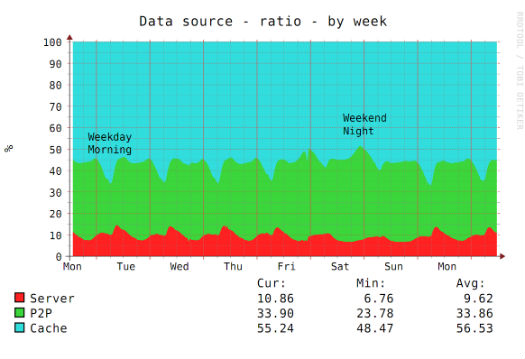Results 1 to 2 of 2
Threaded View
-
19th Jun 2011, 02:44 AM #1
 OPRespected Member
OPRespected Member Website's:
Website's:
FreshWap.com KWWHunction.com Spotify: A Massive P2P Network, Blessed by Record Labels
Spotify: A Massive P2P Network, Blessed by Record Labels

For years the music industry has seen P2P technology as the single biggest threat, claiming that file-sharers are responsible for billions of dollars in losses. However, P2P technology is also part of the music industry?s future. One of the major revelations in the music business, the streaming service Spotify, is actually one of the largest file-sharing networks on the Internet.
When Spotify launched their first beta in the fall of 2008, we branded it ?an alternative to music piracy.? Having the option to stream millions of tracks supported by an occasional ad, or free of ads for a small monthly fee, Spotify appeared to be serious competitor to music piracy.
In the two years that followed Spotify rapidly won the hearts and minds of many music fans. Currently limited to a few European countries only, the service has already amassed more than 10 million users and over a million paid subscribers. A true success story, which has been recognized by the music industry on various occasions.
What?s often overlooked is that Spotify is in reality one of the largest P2P networks on the Internet. No surprise, since one of the lead engineers from the start is none other than Ludvig Strigeus, the original creator of the BitTorrent client uTorrent. However, not much is known about this private P2P network.
Using P2P technology allows Spotify to use less servers, less bandwidth and have a better up-time. And it appears to be working. In fact, of all the tracks that are streamed over the Internet by Spotify users the majority come via P2P connections. Since they?re dealing with copyrighted music, all transfers are totally anonymous, encrypted and secure of course.
Let?s take a look at some data provided by Spotify on their three main music sources.

As can be seen in the graph above most tracks are played from the local cache. These are songs a user has listened to before, and those files are stored on the local hard drive. Of all the remaining tracks that are played, roughly 80% are accessed via the P2P network.
What?s further notable is that P2P performance is most efficient during peak hours and in the weekend. In the graph provided by Spotify the share of P2P traffic peaks on Saturday evening.
Spotify?s P2P network uses various influences from other file-sharing platforms. It uses both a BitTorrent like tracker and a Gnutella style network, but is specifically tailored towards playing relatively small files. Since it?s dealing with streaming, the first bits of a song are prioritized while slow peers are rejected.
This custom P2P solution guarantees what is one of the most important features of Spotify, a very low latency. Tracks have to start almost instantly, and with a median delay of 265 milliseconds it lives up to this expectation. Quite remarkable for a P2P-powered application.
So finally, there we have it. A massive P2P network that?s fully supported and even partially owned by the music industry. Who ever thought that would happen?
Source: (URL)
CyberAff Reviewed by CyberAff on . Spotify: A Massive P2P Network, Blessed by Record Labels http://torrentfreak.com/images/spotify.jpg For years the music industry has seen P2P technology as the single biggest threat, claiming that file-sharers are responsible for billions of dollars in losses. However, P2P technology is also part of the music industry?s future. One of the major revelations in the music business, the streaming service Spotify, is actually one of the largest file-sharing networks on the Internet. When Spotify launched their first beta in the fall of 2008, we Rating: 5Dear Haters,
"I respect you so much, that's why I salute you with 1 middle finger! "
"
Thank You !
Sponsored Links
Thread Information
Users Browsing this Thread
There are currently 1 users browsing this thread. (0 members and 1 guests)
Similar Threads
-
Truth about Record Labels
By george101 in forum General DiscussionReplies: 1Last Post: 17th Mar 2012, 01:08 AM -
Record Labels Threaten the Open Internet, isoHunt Tells Court
By ShareShiz in forum News & Current EventsReplies: 0Last Post: 29th Feb 2012, 05:07 PM -
Record Labels Blame Google For Piracy, Hint At Censorship
By tom247 in forum News & Current EventsReplies: 7Last Post: 17th Dec 2010, 09:02 PM -
Record Labels Face $60 Billion Damages for Pirating Artists
By ACiD in forum News & Current EventsReplies: 10Last Post: 8th Dec 2009, 05:28 AM -
[9/2/08]Record labels can't win for losing
By Lease in forum News & Current EventsReplies: 0Last Post: 9th Feb 2008, 05:50 AM














 Register To Reply
Register To Reply






 Staff Online
Staff Online
themaManager - edit and manage...
Version 4.04 released. Open older version (or...